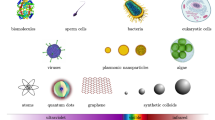Abstract
A short overview of function and experimental set-ups of acoustic wave devices is given which, in contrast to other bioanalysis techniques, are based on a mechanical transduction mechanism. The most frequently used device is the thickness shear mode resonator (TSMR), which in the last few years was intensively employed in biosensor applications. TSMR biosensor studies in the field of nucleic acid interaction, adsorption of proteins to surfaces and immunosensing are reviewed. A main point concerns the interpretation of the sensor response not only in terms of mass loading, which underestimates the capabilities of these devices.
Similar content being viewed by others
Author information
Authors and Affiliations
Additional information
Received: 3 September 1999 / Revised: 10 November 1999 / Accepted: 21 November 1999
Rights and permissions
About this article
Cite this article
Kaspar, M., Stadler, H., Weiß, T. et al. Thickness shear mode resonators (“mass-sensitive devices”) in bioanalysis. Fresenius J Anal Chem 366, 602–610 (2000). https://doi.org/10.1007/s002160051555
Issue Date:
DOI: https://doi.org/10.1007/s002160051555




